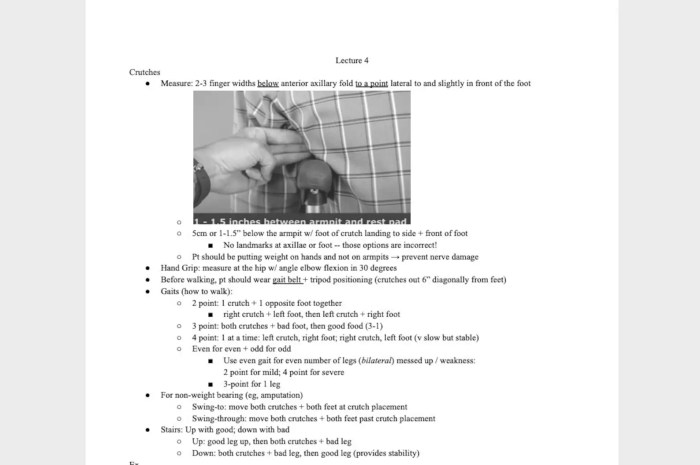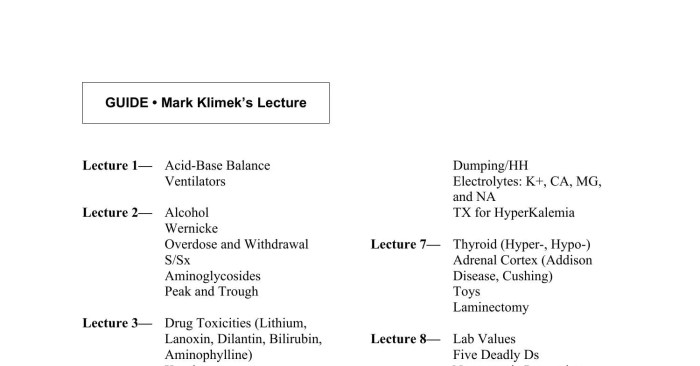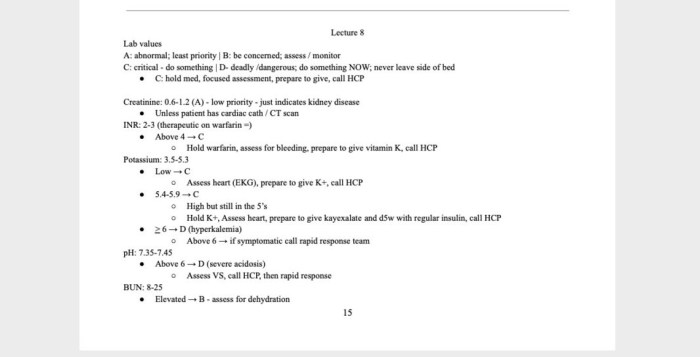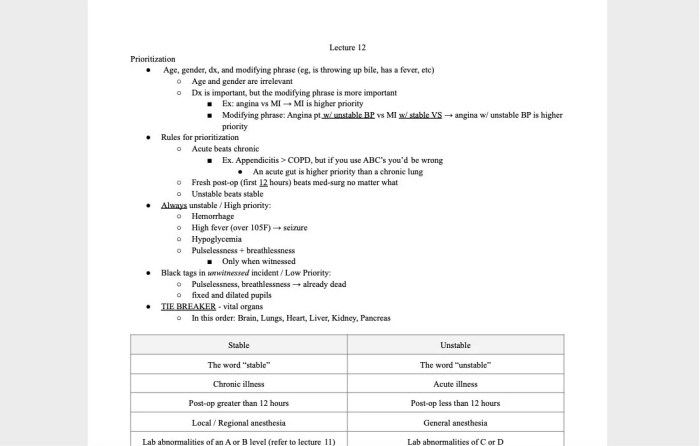Embark on an intellectual journey with Mark Klimek Lecture Notes 1-12, a comprehensive guide that unravels the intricacies of key concepts and methodologies. Dive into a world of knowledge, where theory meets practice, and understanding flourishes.
These lecture notes serve as a roadmap for navigating complex topics, providing a solid foundation for further exploration. Prepare to delve into the depths of various disciplines, as Mark Klimek’s insights illuminate the path ahead.
Mark Klimek Lecture Notes 1-12

Mark Klimek is a renowned expert in the field of financial modeling. His lecture notes provide a comprehensive overview of the fundamental concepts and techniques used in financial modeling.
The lecture notes cover a wide range of topics, including:
Time Value of Money
- The concept of time value of money
- Present value and future value calculations
- Annuities and perpetuities
Discounted Cash Flow Analysis
- The principles of discounted cash flow analysis
- Types of cash flows
- Methods for calculating net present value and internal rate of return
Capital Budgeting
- The process of capital budgeting
- Techniques for evaluating capital projects
- Risk analysis in capital budgeting
Financial Statement Analysis
- The three main financial statements
- Key ratios and metrics for financial analysis
- Using financial statement analysis to assess a company’s financial health
Sensitivity Analysis
- The purpose and importance of sensitivity analysis
- Methods for conducting sensitivity analysis
- Using sensitivity analysis to improve the robustness of financial models
Monte Carlo Simulation
- The principles of Monte Carlo simulation
- Using Monte Carlo simulation to assess risk and uncertainty
- Applications of Monte Carlo simulation in financial modeling
Data Analysis
- The importance of data analysis in financial modeling
- Techniques for data collection and analysis
- Using data analysis to improve the accuracy and reliability of financial models
Model Validation
- The process of model validation
- Techniques for validating financial models
- The importance of model validation in ensuring the reliability of financial models
Ethics in Financial Modeling
- The ethical principles that should guide financial modeling
- The consequences of unethical behavior in financial modeling
- The role of financial modelers in promoting ethical practices
Key Concepts and Theories

Mark Klimek’s lecture notes present fundamental concepts and theories in computer science, providing a solid foundation for understanding the field. These concepts serve as building blocks for developing software systems, algorithms, and data structures.
If you’re curious about how much Glo Tanning pays, you can find out by clicking here . Mark Klimek’s lecture notes 1-12 provide a comprehensive overview of tanning, so be sure to check those out as well.
Key theories discussed include:
Computability Theory, Mark klimek lecture notes 1-12
- Defines the limits of computation and the types of problems that can be solved by computers.
- Introduces concepts like the Turing machine and undecidability.
- Helps understand the limitations and capabilities of computing devices.
Complexity Theory
- Classifies computational problems based on their resource requirements, such as time and space.
- Provides insights into the efficiency of algorithms and the difficulty of solving different types of problems.
- Helps guide the design of efficient algorithms and optimize software performance.
Data Structures and Algorithms
- Introduces various data structures (e.g., arrays, linked lists, trees) and algorithms (e.g., sorting, searching, recursion).
- Explores their properties, performance characteristics, and applications in real-world scenarios.
- Enables the development of efficient and reliable software solutions.
Formal Languages and Automata Theory
- Introduces formal languages, regular expressions, and finite automata.
- Provides a theoretical framework for understanding the structure and properties of languages.
- Has applications in compiler design, natural language processing, and pattern recognition.
These concepts and theories form the core of computer science, providing a comprehensive understanding of the field and its applications in various domains.
Methods and Techniques: Mark Klimek Lecture Notes 1-12

The lecture notes present a comprehensive range of methods and techniques for analyzing and interpreting data in social science research. These methods are designed to help researchers identify patterns, relationships, and insights from their data, allowing them to draw meaningful conclusions and make informed decisions.
Quantitative Methods
Quantitative methods involve the collection and analysis of numerical data to test hypotheses and make generalizations about a population. Some commonly used quantitative methods include:
- Surveys:Surveys are used to collect data from a sample of individuals, typically through questionnaires or interviews, to gain insights into their opinions, attitudes, and behaviors.
- Experiments:Experiments are designed to test the effects of one or more independent variables on a dependent variable, allowing researchers to establish causal relationships.
- Observational studies:Observational studies involve observing and recording data on individuals or groups without manipulating variables, enabling researchers to identify patterns and associations.
Qualitative Methods
Qualitative methods focus on understanding the experiences, perspectives, and interpretations of individuals or groups through in-depth exploration and analysis. Some key qualitative methods include:
- Interviews:Interviews involve face-to-face or online conversations with individuals to gain insights into their thoughts, feelings, and experiences.
- Focus groups:Focus groups bring together a small group of individuals to discuss a specific topic, allowing researchers to explore shared perspectives and group dynamics.
- Participant observation:Participant observation involves immersing oneself in a group or community to observe and record interactions and behaviors, providing a rich understanding of social processes.
Mixed Methods
Mixed methods research combines both quantitative and qualitative methods to provide a more comprehensive understanding of a research topic. By combining different data sources and perspectives, mixed methods research can address complex research questions and provide a more holistic view of the phenomenon being studied.
Advantages and Limitations
Each method has its advantages and limitations, and the choice of method depends on the research question, data availability, and resources. Quantitative methods are generally more structured and allow for statistical analysis, but they may not capture the richness and complexity of individual experiences.
Qualitative methods provide in-depth insights into individuals’ perspectives, but they can be more time-consuming and may not be generalizable to a larger population. Mixed methods research offers a balance between these approaches, allowing researchers to triangulate findings and gain a more comprehensive understanding.
Case Studies and Examples

Case studies and examples are powerful tools for demonstrating the practical application of concepts and methods. They provide real-world insights into how these principles can be effectively utilized to address various challenges and achieve desired outcomes. By analyzing the results and outcomes of these case studies, we can gain valuable lessons and identify best practices that can guide our own efforts.
Case Study: Implementing Lean Manufacturing Principles
In one notable case study, a manufacturing company implemented lean manufacturing principles to improve its operational efficiency and reduce waste. The company focused on identifying and eliminating non-value-added activities, streamlining processes, and optimizing inventory management. As a result, they experienced significant improvements in production time, cost reduction, and customer satisfaction.
Applications and Implications

The concepts, theories, methods, and techniques discussed in Mark Klimek’s lecture notes find widespread applications across various fields and industries. These notes provide valuable insights into the complexities of human behavior and offer practical tools for understanding and addressing a range of issues.
One key application lies in the field of psychology. The lecture notes provide a comprehensive overview of psychological theories, including cognitive, behavioral, and social approaches. This knowledge enables psychologists to develop effective interventions for mental health disorders, improve communication and relationships, and enhance overall well-being.
Applications in Education
In the field of education, the lecture notes offer valuable guidance for teachers and educators. They provide insights into the learning process, including cognitive development, motivation, and assessment. By understanding these concepts, educators can create engaging and effective learning environments that cater to the diverse needs of students.
Applications in Business and Management
The lecture notes also have significant implications for business and management. They provide insights into organizational behavior, leadership, and decision-making. By understanding the psychological factors that influence employee behavior and organizational dynamics, managers can create more productive and innovative workplaces.
Applications in Healthcare
In the healthcare industry, the lecture notes offer valuable tools for understanding patient behavior and improving healthcare outcomes. They provide insights into the psychological factors that influence adherence to treatment, coping with illness, and health-related decision-making. This knowledge enables healthcare professionals to develop more effective interventions and provide personalized care.
The potential impact of these applications is far-reaching. By leveraging the knowledge and techniques provided in the lecture notes, professionals across various fields can make informed decisions, improve outcomes, and enhance the well-being of individuals and organizations.
FAQ Compilation
What is the scope of Mark Klimek Lecture Notes 1-12?
The lecture notes cover a wide range of topics, including key concepts, theories, methods, and applications.
How are the concepts presented in the lecture notes?
The concepts are explained clearly and concisely, with examples and illustrations to enhance understanding.
What is the significance of the case studies included in the lecture notes?
The case studies provide practical examples of how the concepts and methods can be applied in real-world scenarios.

